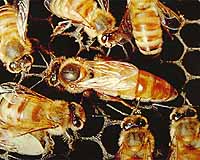| . |  |
. |
Tempe AZ (SPX) Jul 16, 2010 What makes a bee grow up to be a queen? Scientists have long pondered this mystery. Now, researchers in the School of Life Sciences at Arizona State University have fit a new piece into the puzzle of bee development. Their work not only adds to understanding about bees, but also adds insights into our own development and aging. The study, which appeared in the June 30 online edition of Biology Letters, shows that a key protein in the insulin signaling pathway plays a strong role in caste development among bees. A female bee can become either a worker or a queen. Queen bees are larger and live longer than workers. Queen bees are also fertile while workers are essentially sterile. A queen has only one role-to lay eggs-while workers tend the hive, care for the queen and larvae, and forage for food. "The incredible thing is that both of these types of female honeybees emerge from the same genome," says Florian Wolschin, an assistant research professor in the School of Life Sciences in ASU's College of Liberal Arts and Sciences, is the lead author of the study. "So how does that happen?" Workers determine the fate of the larvae by what they feed them. The amount and composition of food that the larvae receive determine whether they become workers or queens. People have known this for many years, but exactly what happens inside the cells to create this split isn't completely clear. Wolschin, Gro Amdam, an associate professor, and Navdeep S. Mutti, a postdoctoral research associate, found that the insulin signaling pathway plays a role in caste development. Insulin is a hormone found in humans and many other animals, and insulin-like peptides have been discovered in bees. Insulin moves glucose-sugar-from the bloodstream into the body's cells where it can be used. The researchers suppressed one of the key proteins in this pathway in honeybee larvae. The protein, called the insulin receptor substrate (IRS), has been linked to growth, development and reproduction in mice. The researchers fed the altered larvae a queen's diet, but they developed into workers, not queens. IRS is only one component of the process that decides a bee's ultimate fate. Wolschin says several other molecules are known to play a role, including DNA methyltransferase, juvenile hormone and a protein called TOR. "Those are all very important and fundamental mechanisms," says Wolschin. "One single part cannot alone be responsible. It has to be the interplay between different mechanisms that finally results in the divergence of queens and workers." The researchers are now looking at the interconnections between several of these factors. "We want to see if maybe there's a hierarchy involved. Several of the components are probably 'upstream' of other processes. So they serve as mass regulators and switches," says Wolschin. Honeybees are vitally important to our economy through pollination of crops as well as production of honey, wax and royal jelly. Understanding bee biology is crucial to maintaining this industry in the face of problems like colony collapse disorder. Wolschin adds that bees also provide an important model system that can help us understand our own biology. For example, scientists have successfully reversed many signs of aging in worker bees. "That is pretty unique," says Wolschin. "You don't have other model organisms in aging research that can do that."
Share This Article With Planet Earth
Related Links Arizona State University The Flowers and Fruits of Earth
 Artificial Bee Silk A Big Step Closer To Reality
Artificial Bee Silk A Big Step Closer To RealityCanberra, Australia (SPX) Mar 08, 2010 CSIRO scientist Dr Tara Sutherland and her team have achieved another important milestone in the international quest to artificially produce insect silk. They have hand-drawn fine threads of honeybee silk from a 'soup' of silk proteins that they had produced transgenically. These threads were as strong as threads drawn from the honeybee silk gland, a significant step towards developm ... read more |
|
| The content herein, unless otherwise known to be public domain, are Copyright 1995-2010 - SpaceDaily. AFP and UPI Wire Stories are copyright Agence France-Presse and United Press International. ESA Portal Reports are copyright European Space Agency. All NASA sourced material is public domain. Additional copyrights may apply in whole or part to other bona fide parties. Advertising does not imply endorsement,agreement or approval of any opinions, statements or information provided by SpaceDaily on any Web page published or hosted by SpaceDaily. Privacy Statement |